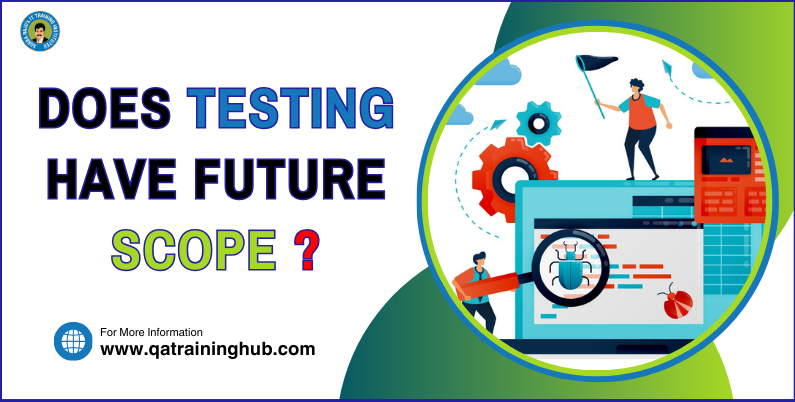
Exploring the Future Scope of Testing: A Crucial Element in Software Development
Testing plays a pivotal role in ensuring the quality, reliability, and security of software applications and systems. As software continues to play a crucial role in various industries and domains, the demand for high-quality software products is ever-growing. However, with the advancement of technology, an important question arises: Does testing have a future scope? In this article, we resolve this question and explore the function of testing in software development lifecycle and its promising future prospects.
The Evolution of Testing:
To understand the future scope of testing, it’s essential to trace its evolution. Testing used to be seen as something done after development was completed, but now it’s seen as a vital component throughout the software development process. Traditional testing methodologies have given way to agile and DevOps practices, which prioritize continuous testing and integration.This change reflects the increasing understanding of testing’s importance in speeding up time-to-market, improvinging customer satisfaction, and reducing risks.
Future Trends Impacting Testing:
Several transformative trends are shaping the future of testing, each presenting unique opportunities and challenges:
AI and Machine Learning in Testing:
Artificial Intelligence (AI) and Machine Learning (ML) are transforming testing by automating routine tasks, predicting defects, and optimizing test coverage. AI-driven testing tools can process large amounts of data, identify patterns, and create test cases, significantly improving efficiency and accuracy. Moreover, ML algorithms can adjust and enhance themselves over time, making testing processes more flexible and responsive to changing needs.
Shift-Left and Shift-Right Testing:
The concepts of Shift-Left and Shift-Right testing are gaining prominence, advocating for early testing and continuous feedback loops throughout the software development process. Shift-Left testing highlights moving testing activities closer to the initial stages of requirements and design, early detection and resolution of defects. Conversely, Shift-Right testing focuses on post-production monitoring and feedback, Using real-time data to improve product quality and user satisfaction.
Test Automation and Continuous Testing:
Automation remains essential in contemporary testing methods, allowing for rapid execution of test cases, increased test coverage, and faster feedback cycles. Continuous Testing, smoothly integrated into DevOps workflows, ensures that testing activities align with the pace of development, enabling rapid releases without compromising quality. Automation frameworks, combined with AI-driven test creation and execution, are set to transform testing efficiency and productivity.
IoT and Edge Computing Testing:
The widespread adoption of Internet of Things (IoT) devices and Edge Computing architectures presents new challenges for testing. With interconnected devices and distributed computing environments, ensuring interoperability, security, and reliability becomes crucial. Testing strategies need to adapt to cover various hardware setups, network protocols, and environmental factors, requiring strong IoT and Edge testing frameworks.
Security and Compliance Testing:
In today’s environment marked by cyber threats and data breaches, security testing takes on significant importance Organizations are prioritizing security and compliance testing to identify vulnerabilities, minimize risks, and ensure regulatory adherence. With strict data protection laws and increasing consumer concerns over privacy, security testing must be integrated seamlessly into the software development process.This includes activities like threat modeling, penetration testing, and code analysis.
User Experience (UX) Testing:
User experience (UX) has become a critical factor in the success of software applications. Testing methodologies such as usability testing, accessibility testing, and performance testing are essential for delivering exceptional user experiences, driving the demand for specialized testing skills.
Future Scope of Testing:
Considering the significant changes reshaping the testing, it’s clear that testing has vast potential for the future.
Continuous Innovation:
With advancements in technology such as artificial intelligence, machine learning, Internet of Things (IoT), blockchain, and quantum computing, the complexity of software applications is increasing. This complexity requires strong testing processes to ensure dependability, security, and performance.
Quality Assurance in Digital Transformation:
Digital transformation efforts are driving organizations to update their IT infrastructure and applications. Quality assurance (QA) plays a crucial role in ensuring the success of these initiatives by validating the functionality, usability, and reliability of digital solutions.
Shift Towards Customer-Centric Testing:
In today’s era defined by hyper-personalization and a focus on customer needs, testing will increasingly focus on delivering exceptional user experiences. Organizations will invest in UX testing to understand user preferences, behavior patterns, and areas of concern, leading to ongoing enhancements in product design and features. By prioritizing customer satisfaction, businesses can gain a competitive advantage and build lasting customer relationships.
Resilience and Security Assurance:
As cyber threats increase and regulatory oversight becomes stricter,the importance of security testing cannot be overstated. Organizations will prioritize resilience and security assurance, Integrating testing methods that actively identify and address vulnerabilities. By taking a comprehensive approach to security testing, which includes both preventive and detective measures, businesses can strengthen their defenses against cyber attacks and protect sensitive information.
Agility and Adaptability:
Agile and DevOps methodologies have revolutionized how software is developed, emphasizing flexibility, teamwork, and ongoing enhancement. Testing will keep pace with these approaches, embracing automation, collaboration, and development cycles fueled by feedback.Testers will need to adapt to rapid changes, utilize new technologies, and cultivate a culture of innovation to deliver value in fast-paced environments.
Conclusion:
As we conclude the exploration of Does testing have future scope?, QATrainingHub leads the way in this transformative journey. Overall, as long as software continues to evolve and play a vital role in the digital economy, testing will remain a critical function for ensuring the quality, reliability, and security of software applications. Testing professionals who adapt to emerging trends, technologies, and methodologies will continue to have promising career opportunities in the future. QA TrainingHub’s dedication to excellence, innovation, and continuous learning distinguishes it as a leading opportunity for both aspiring testers and experienced professionals
At QA TrainingHub, we provide comprehensive training programs designed to equip individuals with the latest tools, methods, and best practices in software testing. Whether you’re a seasoned professional aiming to enhance your skills or a newcomer eager to enter the field, our courses cater to various skill levels and career goals.
In the journey towards shaping the future of testing, QA TrainingHub serves as a trusted partner, guiding individuals towards success in a rapidly changing environment. With a focus on quality, a drive for creativity, and a dedication to empowering learners, QA TrainingHub leads the path
towards a future where testing transcends boundaries, drives innovation, and ensures the smooth delivery of quality software products and services.
Join QA TrainingHub today and start on a path towards a brighter, more promising future in the dynamic world of testing. Learn how Does testing have future scope? Together, let’s grasp the opportunities, overcome the challenges, and shape the future of testing for generations to come.







